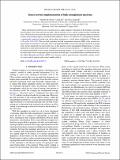| dc.contributor.author | Fu, Liang | |
| dc.contributor.author | Qi, Xiao-Liang | |
| dc.contributor.author | Hsieh, Timothy Hwa-wei | |
| dc.date.accessioned | 2014-09-05T13:35:58Z | |
| dc.date.available | 2014-09-05T13:35:58Z | |
| dc.date.issued | 2014-08 | |
| dc.date.submitted | 2014-07 | |
| dc.identifier.issn | 1098-0121 | |
| dc.identifier.issn | 1550-235X | |
| dc.identifier.uri | http://hdl.handle.net/1721.1/89194 | |
| dc.description.abstract | Many topologically nontrivial states of matter possess gapless degrees of freedom on the boundary, and when these boundary states delocalize into the bulk, a phase transition occurs, and the system becomes topologically trivial. We show that tensor networks provide a natural framework for analyzing such topological phase transitions in terms of the boundary degrees of freedom which mediate it. To do so, we make use of a correspondence between a topologically nontrivial ground state and its phase transition to a trivial phase established in T. Hsieh and L. Fu (arXiv:1305.1949). This involved computing the bulk entanglement spectrum (BES) of the ground state upon tracing out an extensive subsystem. This work implements BES via tensor network representations of ground states. In this framework, the universality class of the quantum critical entanglement Hamiltonian in d spatial dimensions is either derived analytically or mapped to a classical statistical model in d + 1 dimensions, which can be studied using Monte Carlo or tensor renormalization-group methods. As an example, we analytically derive the universality classes of topological phase transitions from the spin-1 chain Haldane phase and demonstrate that the Affleck-Kennedy-Lieb-Tasaki (AKLT) wave function (and its generalizations) remarkably contains critical six-vertex (and, in general, eight-vertex) models within it. | en_US |
| dc.description.sponsorship | National Science Foundation (U.S.). Graduate Research Fellowship (0645960) | en_US |
| dc.description.sponsorship | United States. Dept. of Energy. Division of Materials Sciences and Engineering (Award DE-SC0010526) | en_US |
| dc.publisher | American Physical Society | en_US |
| dc.relation.isversionof | http://dx.doi.org/10.1103/PhysRevB.90.085137 | en_US |
| dc.rights | Article is made available in accordance with the publisher's policy and may be subject to US copyright law. Please refer to the publisher's site for terms of use. | en_US |
| dc.source | American Physical Society | en_US |
| dc.title | Tensor network implementation of bulk entanglement spectrum | en_US |
| dc.type | Article | en_US |
| dc.identifier.citation | Hsieh, Timothy H., Liang Fu, and Xiao-Liang Qi. “Tensor Network Implementation of Bulk Entanglement Spectrum.” Phys. Rev. B 90, no. 8 (August 2014). © 2014 American Physical Society | en_US |
| dc.contributor.department | Massachusetts Institute of Technology. Department of Physics | en_US |
| dc.contributor.mitauthor | Hsieh, Timothy Hwa-wei | en_US |
| dc.contributor.mitauthor | Fu, Liang | en_US |
| dc.relation.journal | Physical Review B | en_US |
| dc.eprint.version | Final published version | en_US |
| dc.type.uri | http://purl.org/eprint/type/JournalArticle | en_US |
| eprint.status | http://purl.org/eprint/status/PeerReviewed | en_US |
| dc.date.updated | 2014-08-28T18:49:19Z | |
| dc.language.rfc3066 | en | |
| dc.rights.holder | American Physical Society | |
| dspace.orderedauthors | Hsieh, Timothy H.; Fu, Liang; Qi, Xiao-Liang | en_US |
| dc.identifier.orcid | https://orcid.org/0000-0002-8803-1017 | |
| dc.identifier.orcid | https://orcid.org/0000-0001-8187-7266 | |
| mit.license | PUBLISHER_POLICY | en_US |
| mit.metadata.status | Complete | |
